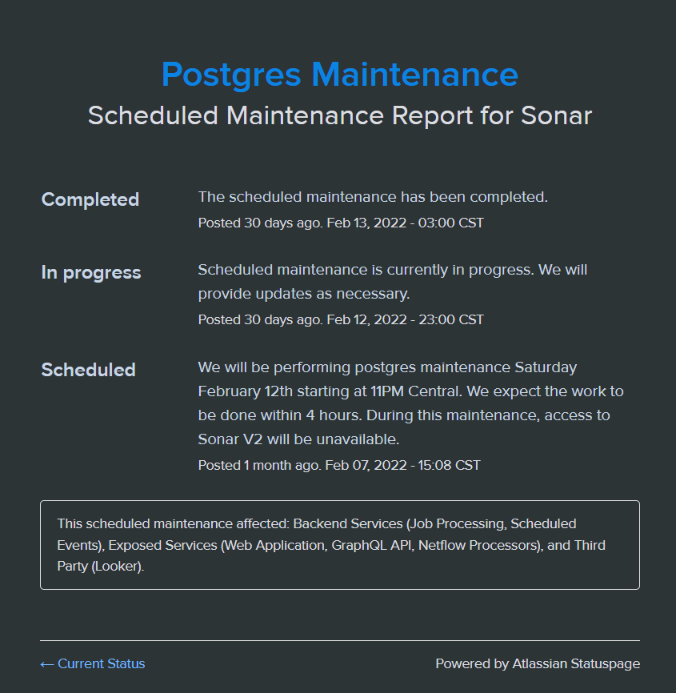Our Products & Services
Getting Started
First Time Setup
Getting Started With Jobs
Getting Started with Accounts
Getting Started with Inventory
Getting Started with Ticketing
Setting Sonar up for Billing
Baseline Configuration
How To: Using Sonar's Customer Portal
User Specific Resources
Accounts
Account Groups: Overview & Example Use Cases
Account List View: Overview
Account Management View: Overview
Account Overview Customization
Account Statuses: Overview & Example Use Cases
Account Types: Overview & Example Use Cases
Anchor & Linked Serviceable Addresses: Overview and Best Practices
Archiving an Account: Overview
CPUC Fixed Broadband Deployment by Address
Child Accounts: Best Practices & How Tos
Creating a New Account
Direct Messages: Overview
Disconnecting an Account
Disconnection Reason Management: Overview
Exploring Task Groups
FCC Broadband Data Collection (BDC) Filings: How Sonar Can Help
FCC Data Exports: General Overview and Usage
Future Serviceable Addresses: Overview
Lead Intake Form Processing
Notes: Best Practices & Use Cases
Scheduled Events: Overview & Use Cases
Serviceable Addresses: Overview and Usage
Specify Account ID upon Creation
Tasks & Task Templates: Overview
Using Sonar's FCC Broadband Label Generation Tool
Billing
ACH Batching: Overview
Accounts in Vacation Mode
Avalara: Overview & Setup
Batch Payments & Deposit Slips: Overview
Billing Calculator
Billing Defaults
Billing Settings
Building Packages
Building a Data Service
Canadian ACH tool
Changing Service Pricing in Sonar: Best Practices
Considerations When Using Avalara with Voice Services
Creating Discounts for Services and Packages
Delinquency Billing Best Practices
Delinquency Exclusions: Overview and Use Cases
Dual Data Services: Overview
Email Invoice Batch: Overview
General Ledger Codes: Overview
General Transactions: Best Practices
How Sonar Prorates Billing
How to Take Bank Account Payments
How to: Adding a Service to an Account
Invoice Templates: Overview
Leveraging PayPal as a Payment Method in Sonar
Manual Transactions
Multi-Month Billing & Multi-Month Services
Print to Mail
Printed Invoice Batches: Overview
Services: Overview
Setting Up Payment Methods and Taking Payments
Setting up Bank Account & Credit Card Processors
Taxes Setup
Usage Based Billing Policies: Overview and Usage
Usage Based Billing Policy Free Periods: Overview and Usage
Using Tax Exemptions - How To
Communication
Communications: Call Logs Overview & Best Practices
Communications: Messages Overview
Email Variables & Conditions
Message Categories: Overview & Use Cases
Phone Number Types: Overview and Use Cases
Saved Messages: Overview
Setting up an Outbound Email Domain
Trigger Explanations
Triggered Messages: Setup
Using Outbound SMS
Using the Mass Message Tool
Companies
How to: Setting Up a Company in Sonar
Managing Multiple Companies in Sonar: Best Practices
Rebranding your Sonar Instance
Financial
Contract Templates
Invoice Attachment Use Cases & PDF Examples
Invoice Messages: Overview & Use Cases
Invoices in Sonar: Examples, Creation & Contents
Integrations
Atlas Digital CORE Integration
Calix Cloud Data Field Mappings
Calix SMx Integration: Overview
CrowdFiber Integration
External Marketing Providers
GPS Tracking Providers: Overview
GoCardless Integration: Overview & Setup
How to Connect Cambium to your Sonar Instance
How to Connect Preseem to your Sonar System
How to: Using Webhooks in Sonar
Integrating with Calix Cloud
RemoteWinBox - Integration with Sonar
Sonar Retain: AI-Powered Customer Retention & Quality Intelligence
The Sonar Field Tech App
Tower Coverage Integration: Overview
VETRO FiberMap V2 Integration: Overview
VETRO FiberMap V3 Integration: Overview
Webhooks in Sonar: Basic PHP Example
iCalendar Integration
Inventory
Inventory List View: Overview
Inventory Model Management: General Overview
Network Inventory: How-to & Usage Guide
Segmentable Inventory: How-to & Usage Guide
Setup of Inventory: Manufacturers, Categories, and Assignees
Tracking and Using Consumable Inventory
Jobs
Applying Task Templates to Jobs
Edit Job Options
Example Jobs & Templates
Geofences: Overview
Job Types: Best Practices
Jobs and Scheduling: Overview
Scheduling How-to: Creating and Booking a Job
Scheduling Week View: Overview
Setting Up Schedules General Overview
Mapping
Misc.
Combining Custom Fields & Task Templates for Information Storage
Custom Fields Overview & Use Cases
Custom Links: Overview
Task Templates Overview & Use Cases
Monitoring
Building Alerting Rotations
Building a Monitoring Template
Poller Troubleshooting
Pollers: General Overview, Deployment Strategy, Build Out & Setup
Networking
Adtran Mosaic Cloud Platform Integration: Overview
Assigning RADIUS Addresses
Assigning an IP Address Using Sonar's IPAM: How to
Automating IP Assignments, Data Rates, and Network Access in Sonar
Building Address Lists
Building RADIUS Groups
Building a Device Mapper
Cable Modem Provisioning
Controlling Customer Speeds with Sonar: General Overview
DHCP Delivery
Data Usage Available Methods
Finding your OIDs
FreeRADIUS 3: Build-Out & Integration
How Sonar Communicates - Egress IPs Explained
IP Assignments & Sonar
IPAM: Basic Setup
IPAM: Overview
LTE Integration
MikroTik as an Inline Device: Integration With Sonar
MikroTik: Controlling Access
MikroTik: Controlling Speeds
MikroTik: Setting Up a Sonar Controlled DHCP Server
Netflow On-Premise Integration: Setup and Overview
Network Dashboard: Overview
Network Sites: Management View Overview
PacketLogic: Integration With Sonar
Pulse, Polling, and PHP
RADIUS: Build-Out & Integration with Sonar
RADIUS: Building Reply Attributes
Setting Up CoA Proxy
Sonar Flow
Sonar IP Addressing
Using Multiple Network Devices in Sonar
Purchase Orders
Release Notes
Reporting
Enhanced Business Intelligence - Tips & Tricks for Advanced Users
How To Enhance Your Reporting With Custom Field Data
Report Licenses
Sonar's Business Intelligence: Overview
Understanding Sonar Reports
Using Sonar DataConnect to Connect BI Applications with Your Sonar Instance
Security
Application Firewall: General Overview and Best Practices
Auth0: Overview
Multi-Factor Authentication: Overview
Password Policy In Depth
Removing a Terminated Employee In Sonar
Role Creation using GraphiQL
User Role Creation & Best Practices
Users: Overview
Sonar Billing
sonarPay
sonarPay Canada Disbursements: Overview
sonarPay Chargebacks & Disputes: Overview
sonarPay Disbursements: Overview
sonarPay Monthly Statement: Overview
sonarPay Overview
sonarPay Reversals, Voids, & Refunds: Overview
sonarPay: Token Migration Process
System
A Deeper Dive into the New Sonar API
API Calls Using Third Party Applications: Personal Access Tokens
Browser Compatibility and Minimum Hardware Requirements for Sonar
Consuming the Sonar API
Controlling Your Landing Page: Personal Preferences
Customizing Your Customer Portal
Date/Time Picker: Overview
Dynamic Time Zones in Sonar
Filtering: Overview
Frequently Used Terms
Getting Your Data into Sonar
GraphQL Rate Limiting Overview
How To Use GraphiQL to Understand the Sonar API
How Your Data is Backed Up
How to Best Use Global Search
Interacting with Files via the API
Introducing the New Sidebar
Main Menu: Overview
Mutations in the Sonar API
Notification Preferences
REST API Wrappers for V1 Compatibility
SMS Notifications
Sonar's Rich Text Editor
System Settings: Overview
The New Sonar API
Troubleshooting the Customer Portal
Upgrading your Ubuntu OS - Customer Portal Upgrades
User Profile: Your Personal User Settings
Ticketing
Advanced Ticketing Features
Canned Replies Examples & Templates
Canned Reply Categories
Exploring Ticket Groups
How Sonar Manages Spam Tickets
How to Integrate Inbound Mailboxes with Slack
Inbound Mailboxes Example Build
Ticket Category Families & Ticket Categories: Overview
Ticket Resolution Reasons: Overview
Ticketing: Overview
Using Parent Tickets
Voice
API Changes for Voice Billing
Best Practices to Remain CPNI Compliant
Billing Voice Services in Sonar
Deploying Voice Services in Sonar
Working With the Sonar Team & Additional Resources
Sonar's Security Practices & Certifications
Sonar and General Data Protection Regulation (GDPR)
Sonar's Security Strategies
Technical Security Overview
Best Practices for Fast Tracking a Support Request
Feedback Portal / Suggest a Feature
Learning with Sonar: Tools and Resources
New Client Training Overview
Sonar Casts Table of Contents
Submitting Bugs vs. Feature Requests
The Sonar Community Forum
The Sonar Status Page
Third Party Customer Support Referrals
Table of Contents
- All Categories
- Working With the Sonar Team & Additional Resources
- The Sonar Status Page
The Sonar Status Page
Read Time: 6 mins
The Sonar Status page is used to relay information and provide updates around Sonar's uptime/downtime, system metrics, as well as both ongoing and past incidents. This article will provide details on the information and actions you can access from this status page along with how you can set yourself up to receive automatic updates for incidents.
The Sonar status page is available here: https://status.sonar.software/
Current Status Page
The Current Status page is the first screen you will land on when accessing https://status.sonar.software/. It contains a few different sections which are discussed in more detail below.
Subscribe to Updates
Subscribing to updates is a great way to ensure you are kept in the loop for any outages or interruptions that come up and for corresponding updates as the team works to identify and resolve the root issue. There are several different ways that the updates can be sent out, such as email, text message, Slack, or webhooks - simply click the "Subscribe to Updates" button on the main screen, select the notification method, complete any necessary fields (if applicable), and you're all set!

Each option available will provide details on the events you will be notified of when subscribing.
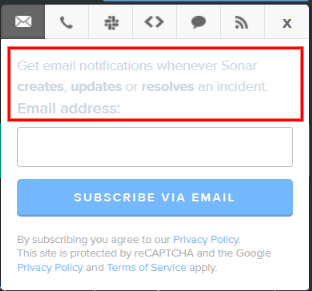
Active Incidents
If there are no ongoing incidents, the current status screen will appear with an "All Systems Operational" message, as can be seen below.

If, however, there is an ongoing incident, details about the incident will be displayed here instead, as can be seen in the image below.
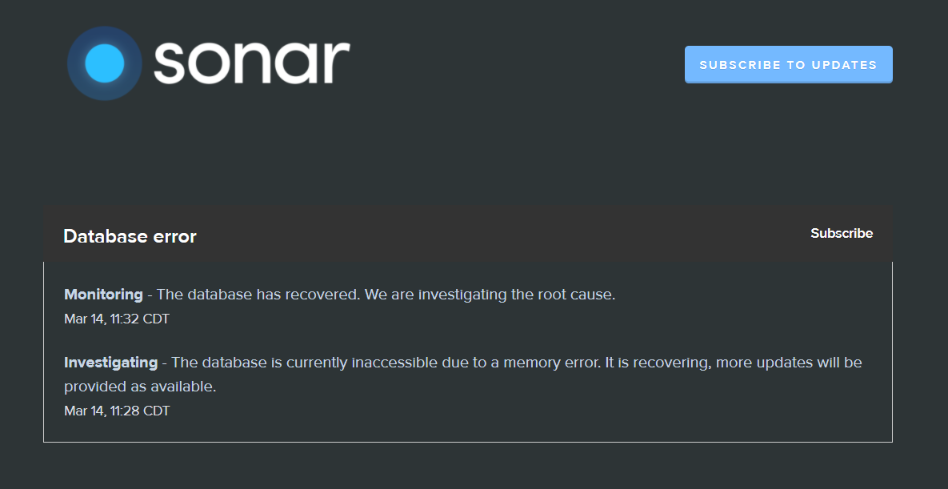
There will be a banner across the top of the incident that provides the incident name (which is "Database error" in the example image above) and a button to "Subscribe" to updates for this specific incident. Although we recommend subscribing to all general updates, you can subscribe to updates for just specific incidents via email and/or text message - simply click "Subscribe", fill out any necessary fields, and you'll receive email notifications when incidents are updated and text message notifications whenever Sonar creates or resolves an incident.
Clicking on the incident name in the banner will also open a new page where you can view all details for that particular incident, including what the incident affects within Sonar.
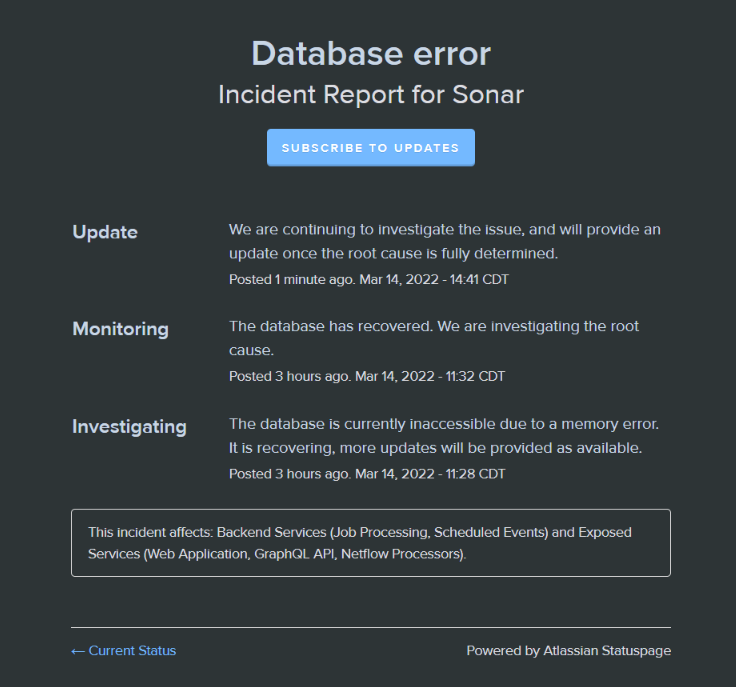
Uptime
A little further down on the main status page you will find a record of Sonar's uptime/downtime for the last 90 days. Each vertical bar represents a day in the last 90 days and hovering over each one will provide additional details for that day. Green indicates no downtime, grey means no data exists for that day, and yellow/orange will be used to indicate some sort of event/issue.
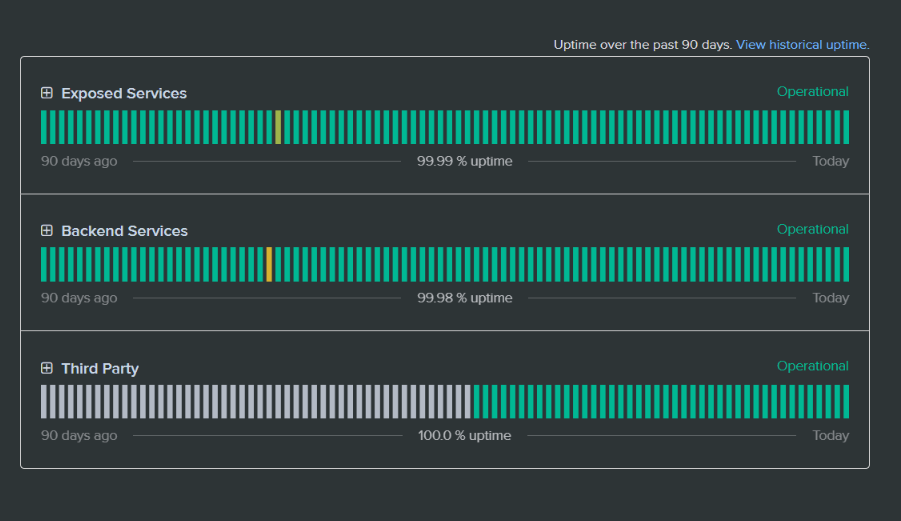
By clicking on an individual bar, or by expanding either of the "Exposed Services", "Backend Services", or "Third Party" groups, you will see the uptime/downtime for any child components that make up that group.
Using the image below as an example, the Exposed Services group contains the following child components: Web Application, GraphQL API, and Netflow Processors. Hovering over the "?" icon next to each child component will provide further details on that component.
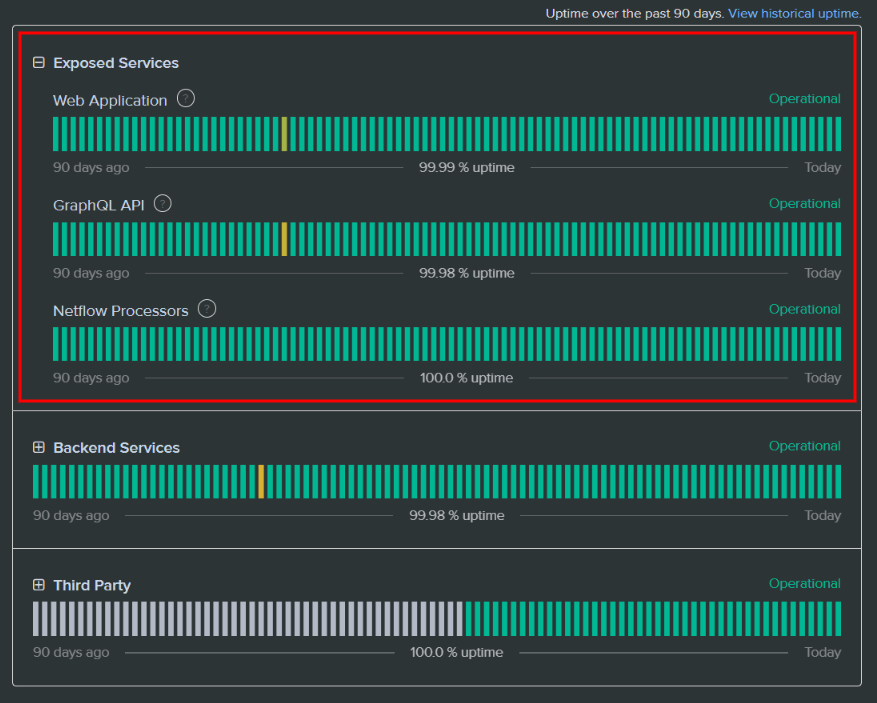
Historical Uptime
The uptime for the last 90 days will be displayed within the current status screen, but historical uptime data outside of these 90 days is also available by clicking the "View historical uptime" link at the top of the uptime segment.
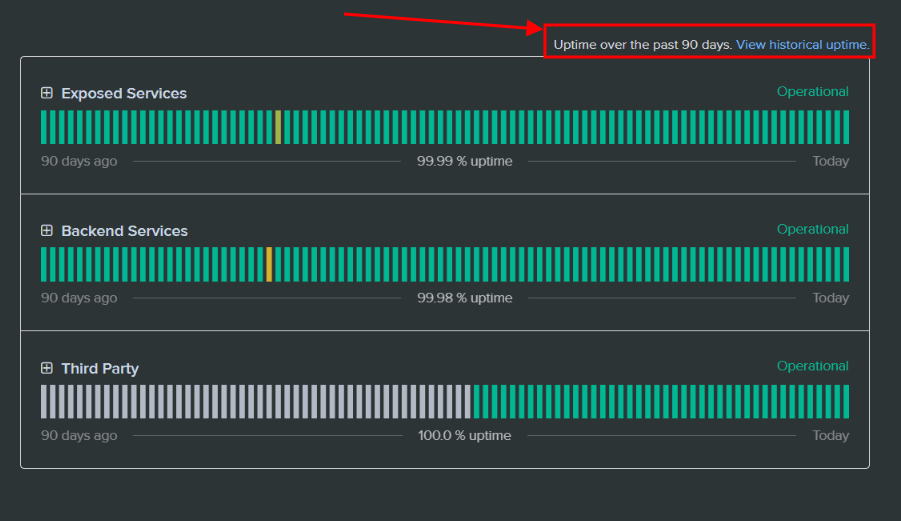
By clicking this link, you'll be taken to the Historical Uptime screen where you can further inspect uptime data via a calendar view. The dropdown can be used to filter the uptime data to just specific groups or child components/services, and the date toggle allows you to go further back in time than just the last 90 days. Hovering over the squares within a month will provide additional details for the uptime on that specific day as well. Each day will also appear as a color, similar to the individual bars for the uptime on the current status screen, with green indicating no downtime, grey indicating no data for that day, and yellow/orange indicating some sort of event/issue.
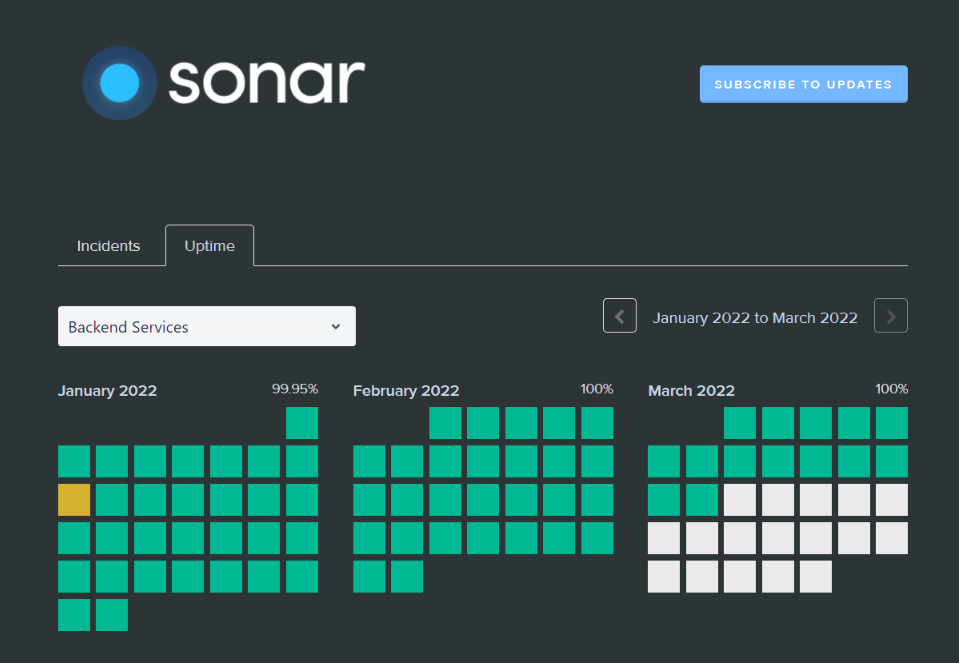
System Metrics
Below the uptime stats on the Current Status screen, you'll find a section dedicated to system metrics that includes data for HTTP response time and GraphQL API response time. By default, it will show the data for the day, but you can toggle the graphs to see past data by using the "Day", "Week", or "Month" options in the top-right corner. Hovering over the "?" icons next to the graph titles will provide details about what this data is referring to.
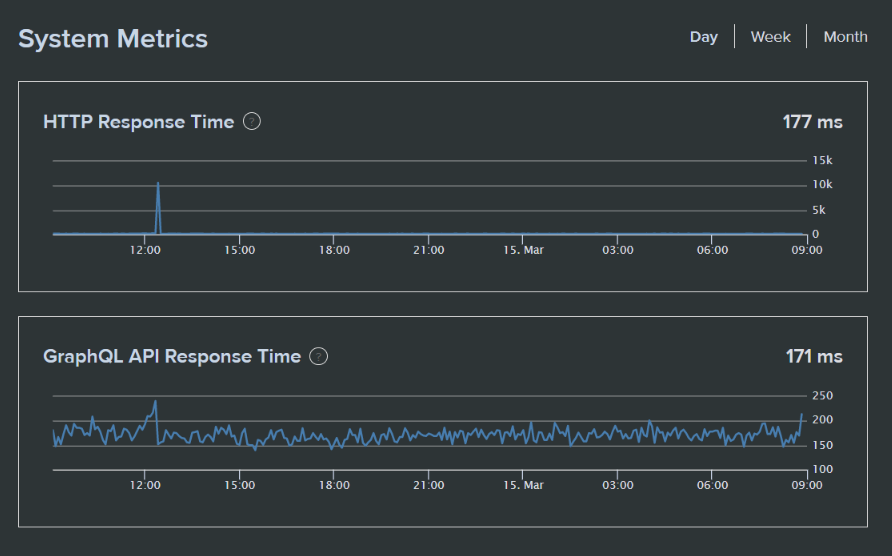

Past Incidents
The last segment, at the bottom of the current status screen, is a section dedicated to past incidents and their details. Each day will have an entry and indicate whether there were no incidents reported, or provide the details for the incident if one occurred.
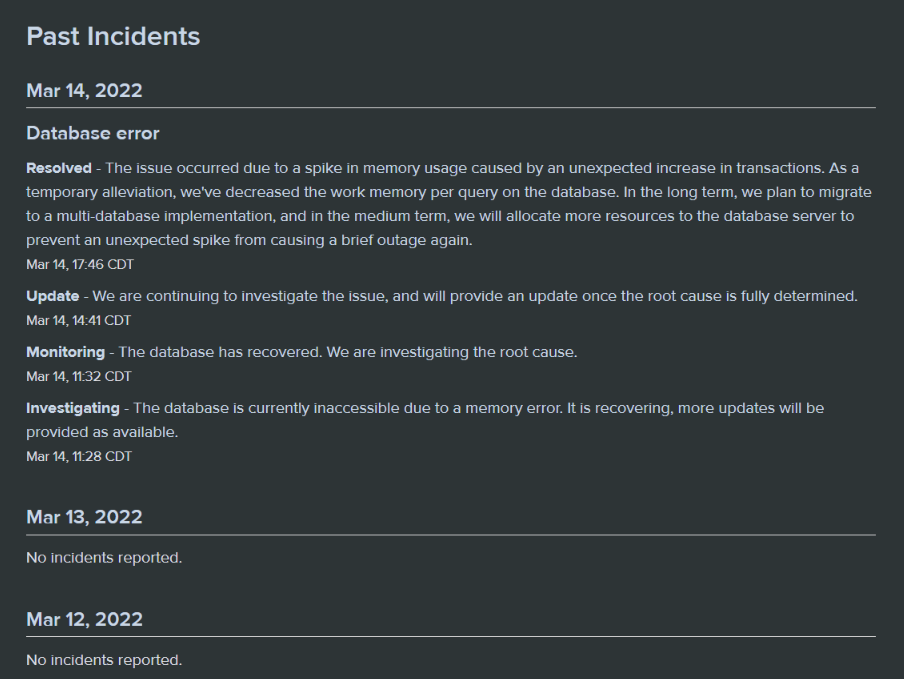
Incident History
The incidents displayed in the Past Incidents section will be the most recent, but you can also view historical data for incidents previous to this point in time. At the very bottom of the Past Incidents section, you will see the link to "Incident History" - this will take you to the screen for the historical incident data.

The Incident History screen will provide details for any outages or disruptions that happened in the past, organized by month - this will include any planned or scheduled maintenance as well. The incident history for the last 3 months is displayed by default, but through the date toggle in the top-right, you can change this to view historical incident data for further back in time.
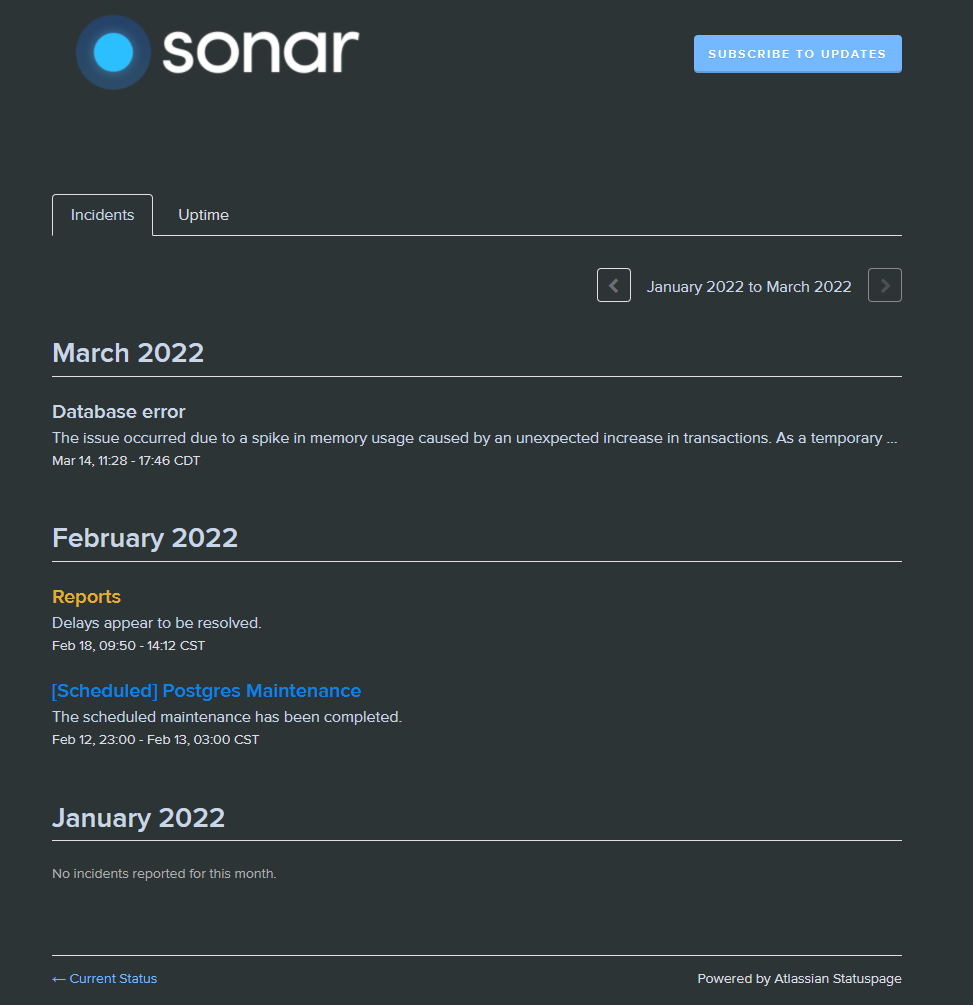
For any incident that appears on the Incident History screen, you can obtain further details for it by simply clicking on the name of the event. This will take you to a new screen where data for just that specific incident can be viewed.
For example, after clicking on the incident name "[Scheduled] Postgres Maintenance" (in the above image), we are taken to a new screen where we can view all of the details for this specific event (pictured below).
